In a world where change comes more quickly every day and everything seems fleeting, is it any wonder so many of us have a difficult time decluttering sentimental items?
Let’s talk about decluttering memorabilia and how to part with sentimental items. Using concepts like ‘grace and space,’ I’ll give you 5 key strategies to deal with those objects that you can use along with my other declutter tips.
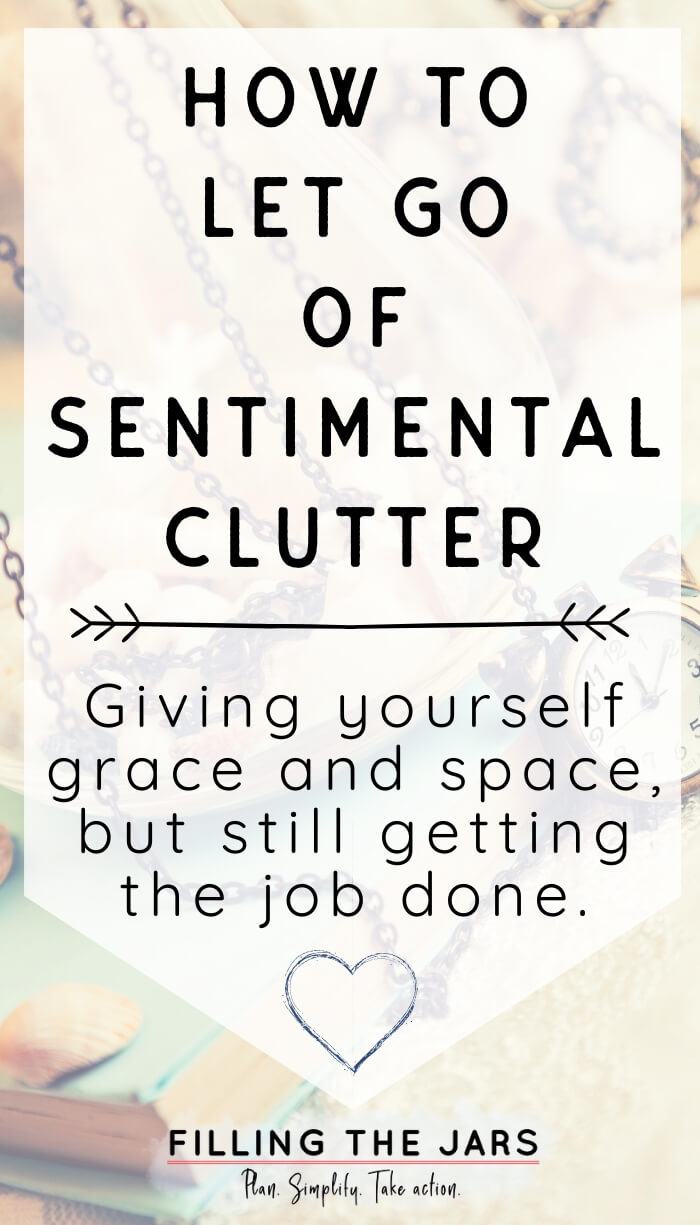
This post may contain affiliate links. If you choose to purchase through an affiliate link, I may receive a small commission at no additional cost to you. You can see my full disclaimer here.
Why Is Clearing Sentimental Clutter So Hard?
Those things are real. Solid. They have memories attached.
How can we possibly get rid of our children’s baby clothes that haven’t been worn in 20 or 30 years? Or the special things we’ve kept from our own childhood?
We’re afraid of forgetting the precious memories, and we tell ourselves the only way to NEVER forget is to hold on to all.the.things.
There are similar issues with things we’ve inherited. We worry about how people would FEEL — even if they are no longer around to use or appreciate those things. ‘I can’t possibly let go of those Victorian antiques that have been in storage for 15 years. Those were my grandmother’s.’
*sigh* I hear you. I really do!
The thing is, hoarding sentimental clutter has negative effects that outweigh the positive memories we THINK we’re preserving. You’re actually hurting yourself and possibly your family when you allow yourself to become The Keeper of the Things by default.
It’s so difficult to separate feelings and memories from THINGS. But it is possible to accomplish gracefully, gently, yet firmly. And the good news is that it becomes easier with practice.
Is It Really Necessary to Remove Sentimental Clutter?
To put it bluntly, yes.
If everything becomes sentimental, then nothing can really stand out. It all turns into general clutter, and those special things get lost in the noise of the generic.
You absolutely cannot keep every single thing that has a memory attached to it.
That’s not saying you have to become cold-hearted and live without keeping ANYTHING, all in the name of being clutter-free.
Decluttering sentimental items that don’t mean AS much allows you to truly appreciate the things you CHOOSE to keep.
Your objective is to let go of the sentimental clutter that is:
Keeping you chained to the past
If you can’t move on in your life because you’re weighed down by memories that are strongly attached to items, it’s important to understand the necessity of allowing yourself to live in the present.
A financial or spatial burden to store
If you have to pay for storage space or live in a larger home than you really need simply to keep all of the sentimental items you’ve collected or inherited over the years, it’s time for a mental reset.
Causing friction with your family
To be fair, most emotional conflict isn’t really about the ‘stuff.’ However, if holding on to too many ‘important’ things and memorabilia is a constant source of fighting or guilty feelings, it’s time to resolve this problem.
You don’t have to clear your home down to bare walls and floors. Let’s talk about some ways you can keep the most important things and let go of the rest with less pain…
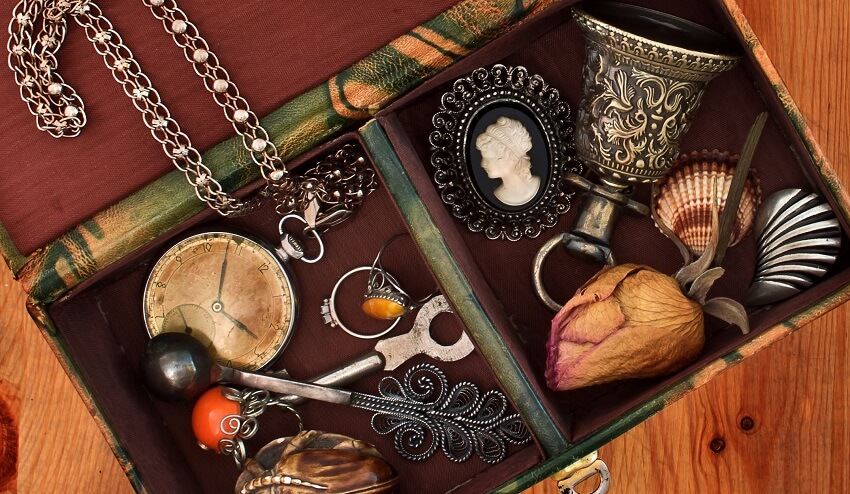
How CAN You Let Go of Sentimental Items?
Here are the 5 keys you can use:
- Start small and slow
- Think in layers and stages
- Ask questions
- Make firm decisions
- Enjoy the things you choose to keep
Start small and slow
When clutter is emotionally overwhelming, you absolutely MUST give yourself ‘grace and space.’ Decluttering sentimental items brings out strong emotions, so be gentle with yourself at first.
Work for short periods of time. You may only be able to get through 10 minutes at a time, or one small box per day. It may not feel like much, but every step forward is progress.
As you make headway, you will gradually learn to be tougher on the clutter. It gets easier when you can SEE the progress you make as you reclaim your living space.
Think in layers and stages
Choosing which objects to keep and which to let go feels nearly impossible when we’re buried under years of clutter. We may WANT a functional space, but we just can’t let go of the stuff, especially when it feels like we’re going to toss memories at the same time.
Knowing we don’t have to get rid of everything right away can be a huge relief. That’s why I recommend slow decluttering and working in layers from easier to more difficult.
When it comes to decluttering sentimental items, always begin with the easiest things you see.
For example, stage 1 might be the kitchen. Or perhaps boxes from the basement that you almost let go once upon a time. You may now be ready. 🙂
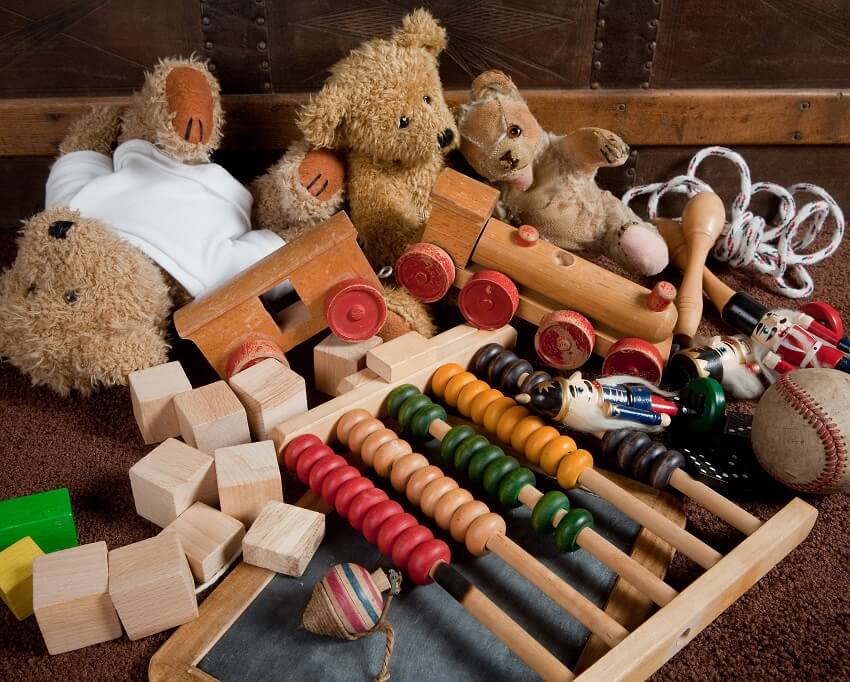
Ask questions
Here are some questions I’ve used to turn my thinking from ‘I have to keep this uber-special thing’ to ‘I’m okay with letting this go.’
How much of this collection do I NEED?
Okay, say you have a few bins full of your child’s school papers and projects and memory items. Do you really need ALL of them?
Could you let go of 25% and still have enough to remind you of their childhood years? How about 50%? Too much right now? That’s okay. Remove 25%, see how you do, and then go back again in a month or two and see how it feels to let go of more.
Eventually, your goal could be to fit everything into a childhood memory box. That would be like going from stage 1 to stage 2 or even 3 if it takes you a few tries to condense everything.
This goes along with learning to recognize how much mental and physical space every item you own takes up.
Would Great Aunt Marguerite REALLY want me to keep this forever?
I see so often where people hold on to EVERYTHING they’ve inherited or been given because they THINK they ‘should.’ That’s nearly always misguided thinking.
I love when I see people have breakthrough in their thinking about sentimental items.
If the original owner of your sentimental object is available, you may want to have a conversation with them. You will probably learn they don’t even remember the object… not because of dementia, but because it wasn’t AS important as you’ve built it up to be.
If you’re working through sentimental clutter and can’t really talk to anyone about it, please assume that anyone who previously owned an object would never want to burden you. It’s okay to let things go when they no longer fit into your mental or physical capacity!
You could also offer the object to another family member or ask the original owner if they would like it back. Just please be cautious of doing this as an excuse to not let go completely. Also, LISTEN to the answers you get. If you’re holding on to ‘treasures’ from your child’s teen years, but they are now grown and tell you they don’t want those things, then please let the items go.
Who will take care of this after I’m gone?
Ohhhh… there’s a good question, and it goes along with what we just discussed.
Do you really want to burden your children or other family members with the responsibility for handling mountains of objects that have no meaning to them? No, of course not!
Items with historical value can be donated to historical museums. This allows others to enjoy the items, yet lifts the resposibility of care from your shoulders.
For items like family records or letters that nobody in your immediate family wants to take care of, consider contacting genealogical societies.
Be kind and thoughtful… clear the clutter now.
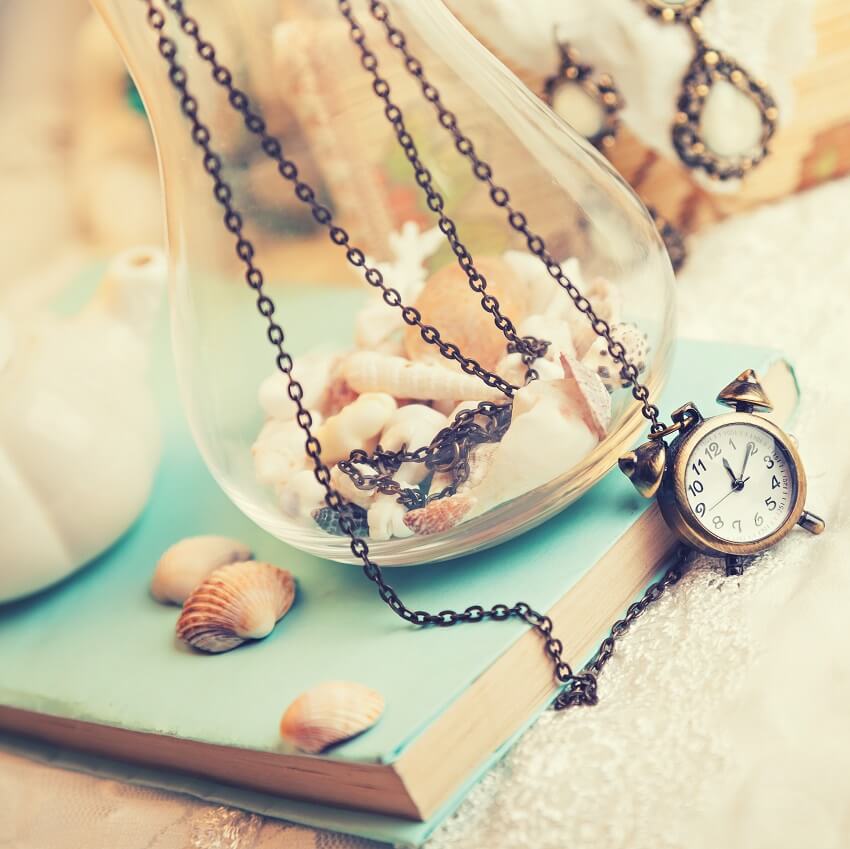
Will a picture work just as well to preserve this memory?
Often just seeing a picture of an object or a drawing brings back the positive memories.
I think about this when I see those ‘remember these’ posts pop up on Facebook with collections of photos of items from the ‘70s and ‘80s that bring back so many memories. Even if I still had some of those things, holding them and looking at them ‘in real life’ wouldn’t make me remember more. Seeing the pictures serves the same purpose… and I don’t have the ‘stuff’ taking up space in my home.
Whenever possible, take a picture and let the physical item go. Write a journal post about the picture, make a memory book. Have it printed if you’re not scrapbook-crafty. This is actually a better option than keeping ‘things’ and then eventually forgetting the stories that go along with the objects.
Why am I holding things that others could use and love?
This question is especially effective for memorabilia items that have been stored so long, you’ve nearly forgotten them.
Storing and ignoring is a poor choice for anything you don’t need, so never feel guilty about passing along useful items to those who will appreciate them. Allowing others to enjoy and use those things is actually showing great respect for the items.
Make firm decisions
If your items have already survived all of the previous questions, it’s time to ask yourself one final thing…
How can I enjoy this item in my everyday life?
If you can’t answer that, then it’s time to be ruthless and let go of the item. Period. End of discussion.
Does that sound painful right now? Yes, at first it may be difficult. That’s why I recommend starting with the things that are easier to declutter. Practice, practice, practice making those decisions.
How do you decide what memorabilia to keep?
There’s absolutely nothing wrong with keeping a reasonable amount of items you TRULY love and enjoy.
Anything that passes the tests we’ve discussed can be considered a ‘keeper.’
What should you do with the sentimental objects you really love and decide to keep?
- Set up a memory box, limited to one per family member.
- Make a photo memory journal or book.
- Create quilts or framed displays for your own home or gifts.
- Use objects like ‘special’ dishes every day.
- Make a memory wall of photos and artwork. This video has some cute suggestions:
However, don’t fall into the trap of thinking you can display or be creative with EVERYTHING.
NOBODY can collect, use, and LOVE everything equally. You may have a great capacity for love and appreciation, but please remember these objects are JUST THINGS. In order to protect yourself, you have to learn limits.
Also, remember that keeping these objects is for your enjoyment only. Just because you love them, does not mean anyone else will want them. Think about that before you decide to gift your memorabilia to others.
More Posts to Help You Declutter
Stop Being a Victim of Clutter
62 Things to Declutter That You Won’t Miss at All
Exactly Where to Start Decluttering Your Home
Final Thoughts on How to Deal With Sentimental Clutter
Decluttering sentimental items is probably THE most difficult part of clearing your home. There’s nothing wrong with taking it slow, letting yourself cope with the feelings, and taking time to get used to the absence of a few objects at a time before letting go of more.
Remember the 5 keys:
- Start small and slow
- Think in layers and stages
- Ask questions
- Make firm decisions
- Enjoy the things you choose to keep
If you want a clutter-free home and mind, it’s absolutely imperative to learn from the past, treasure the good memories, but keep moving forward in your life.
Also, don’t be afraid to reach out for help. If you can’t let go of things due to trauma you’ve experienced, please talk to a mental health professional.
Give yourself grace and space as you work through these difficult things, and you will be well on your way to Building Your Best Life.
You’ve got this!
Grab this printable mini decluttering plan and get started today!
Did you enjoy this post? Know someone else who might like it? Please take a moment to share on Pinterest, Facebook, or your favorite social media… (Click the sharing buttons at the bottom of the post.) Thank you!
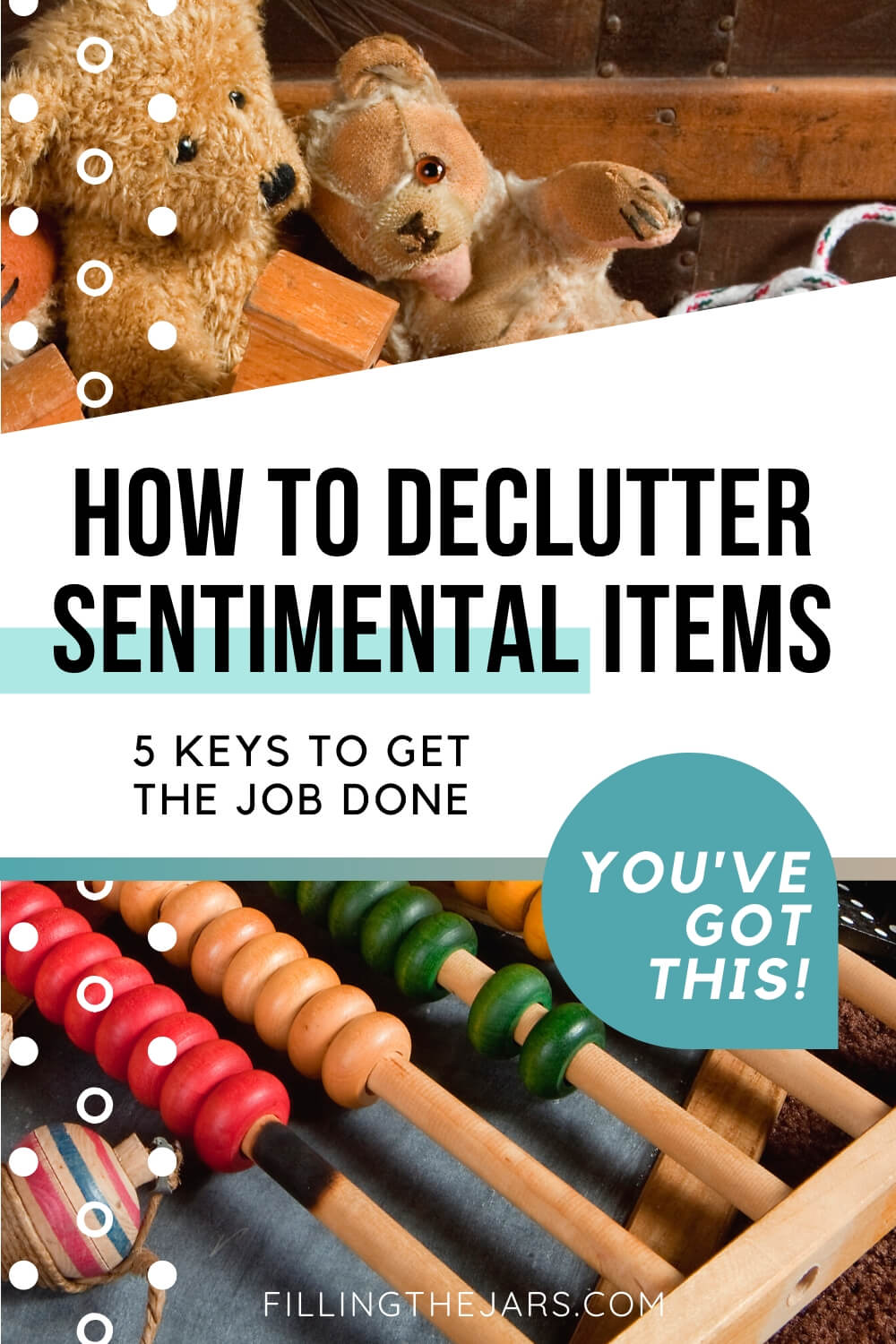


Thanks for the post Julie, sentimental items. I so get this post. There was a post earlier in April around the 18th I think that another person was talking about decluttering with sentimental items and it feels like that is just what I have been doing for the last 5 months. Our house is not that bad, however, there are some huge emotional attachments to some of our kids things (now aged 27 to 30 and out of the house for a while). It all started with rethinking the game room in November which led to looking at our daughters bedroom that was just off of it. First though, I had to make decisions about furniture that was my Aunt and Uncle’s that we got when they died. Talk about emotional impact. However, I had seen some friends who had recently changed up their houses and that inspired me and my husband was ready to part with them too, (the ping pong table that our kids played on took a little longer for him to let go of :)). So, much of the furniture went to Goodwill, one piece I sold on consignment and I really am so glad that other people can now enjoy their furniture. While doing this, I tackled our daughter’ room which was the same since middle school and although she had really moved out a lot of personal stuff, it was amazing how much was still there. And it all had memories:). But with her encouragement and blessing, I again went through giving away items, keeping what I liked and also keeping some of her items that really reminded me of her and one of the hardest parts, painting her room. When I finished, I realized, she is still here (she actually lives in town), and her room will always remind me of her. Did I really need to keep her middle school National Junior Honors certificate up and framed! No instead I kept her senior picture from high school and her recent engagement picture. After the success in her room, I tackled one of our sons’ rooms. For 8 years I have been asking him to clean out his closet, which he never did. When I asked again to do it virtually with me, he said he didn’t have the time. Well, that sort of inspired me, so I started painting his room and then tackled the closet. About 50% of his things went into plastic bins for him to sort through at some point, and the other 50% I rearranged in his closet, he loves books and so now those are in the closet. They still remind me of him, and I got his college diplomas framed so they will be in the room. Last night I tackled the jack and jill bathroom linen closet in the bathroom between the boys room. You may have had the same thoughts running around your head that I did or you may get a laugh out of some of them . . . “That’s still a good towel, why should I give that away? I can’t believe this is still in here, it has stains all over it? Do I really need that comforter that no one has really used in 10 years? One Twin bed set I still couldn’t give away or 1 towel that I got specifically for each of our kids. The good news though, about 1/2 to 2/3 of what was there was repurposed outside of the linen closet and much of it went to Salvation army today. So, emotionally attached absolutely on the craziest things. But I do enjoy the bedrooms even more now. And I’ve learned somethings about myself. First, this decluttering has been going on for about 5 months now and the upstairs has been in some sort of chaos for 5 months, I am a little burned out. I’ve learned that I need to have a time limit to having things messed up and sort of torn apart, and although I’ve gotten a lot of things done, 5 months is too long to have that kind of working around piles, paint brushes, etc. around. The last big hurdle is determining which pictures/art work we really want to keep. Over the last 4 weeks I’ve been taking them down from the rooms and laying them out on the game room floor. The goal is to make those decisions this week so that when I start working with an interior designer the end of April, I really will have a new feel for what we’d like our game room to become with thoughts of where we are now in life, our adult children and their lives and our friends. That’s sort of exciting! and I wouldn’t have been able to do it, if I hadn’t worked through some of that emotional attachment and decluttering! Now we just need to make sure we are not RE cluttering!
This is so thoughtful. I see myself as pretty good about clutter, but it’s tough to throw stuff out when you go down memory lane. I finally took photos of all the kids’ papers except for a few. I need to tackle photos next! Thanks for the tips. 🙂
Thank you for all of the wonderful suggestions! It will really help me finally start to declutter. I think the most helpful for me is to consider how my clutter will affect those who will have to deal with it when I am gone. After cleaning out my parent’s home, my son mentioned how much we are leaving for our children to “clean out”. I have to consider that! I even have clothes that belonged to my grandmother! My granddaughter loved them, and took some that fit her :). But I don’t need them. It was amazing to see; I will take a picture, and get rid of them.
Thank you for you thoughtful, sensible suggestions.
My clutter is hobby clutter and amazing amounts of genealogy items and expensive, incredible collections. For example; I have file cabinets, papers and documents and PHOTOS, and albums, (original and antique certificates, and full of 1800’s card photos, postcards and even tintypes, etc.) And even some “not related” to me, which were given to me to keep. I have 20 plus hand sewn, museum quality quilts. And family dishes, jewelry, etc. And I sew, read, and have additional clutter from making junk journals. Also, I can still wear (size-wise) my high school majorette costumes and my prom dress and wedding dress, so I have lots and lots of clothes since they all still fit. I have a dozen collections that I am pairing down…..but it is so difficult letting go….. and all organization people say have a”throw away” pile. Well as I look around the rooms there is nothing to throw away, because that is easy for me if it is not working, or stained or not-usable or trash, it is instantly thrown away….so you can see my problem is bad.
Hi
I had boxes upon boxes of cards and photos. I scanned all the cards and now they are on a chip. I then scanned every photo I possessed. Sorted them into groups i.e. Halloween, family holiday, school play etc. I chose the best group photo and an individual of each child. The rest were put into folders on computer then onto a USB stick and I just have to put the chip in and browse through them now. So now instead of 20 boxes of photos and 7 of cards I have one large photo album and 14 chips which fit nicely into an old tiny plastic box, same for the cards. I felt so good afterwards.
I have a collection of music boxes. Ceramic or brass figurines, plastic or wooden boxes, snow globes, dolls, decanters, etc. I’ve been collecting for 40 years. Family and friends (most are no longer alive) have been major contributors to my collection. My late husband built a custom curio cabinet for my collection. The cabinet is 6 feet long, 6 feet tall, and 14 inches wide. It’s extremely heavy (I can’t move it by myself). The cabinet is full … even crowded. At last count I had over 300 music boxes. Oddly enough I have very few that play the same melody. None of my family or friends want any of the music boxes. I want to down-size and declutter. But this collection is giving me grief every time I think about getting rid of any of these. I can’t seem to let go of the collection or the curio cabinet. How do I let go?
Quite simply “ THANKYOU “ for this post, I feel this will really set me free. Holding onto past memories is stopping me living in my present. Kind Regards Sylvia x